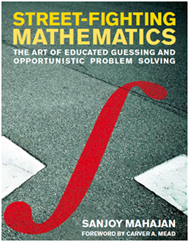The title is meant to convey the message that many problems in mathematics can be solved using elementary tools, more of a street fighting kind than some heavy weight combat type tools. There have been many other books in this genre that highlight the importance of smart guessing and approximations but this book is exceptional in one way – It shows that math problems like solving differentiation, integration, differential equations, etc. which are typically not dealt in pop science books, can also be solved by street fighting tools. There are many non linear differential equations too, that can be solved using the tools mentioned in the book. I guess this book is particularly targeted towards those who need to deal with some kind of math on a daily basis. What does the book contain? There are six tools mentioned in the book:
-
Dimensional Analysis: This is the classic Physics 101 technique of using dimensions of various quantities in the formula to check its validity. However the author shows enough examples to display its power in a variety of problems from integration to solving differential equations.
-
Easy cases: This tool entails using easy cases to check a proposed formula or solution and construct low entropy expressions that pass all easy-cases tests. For many problems in geometry, this tool is very potent. In fact this tool is something we all intuitively use but probably never pay attention to the fact that we are using such a technique.
-
Lumping: This tool turns calculus on its head and solves problems not by “calculation on infinitesimal intervals” but by “lumping intervals”. There are techniques like 1/e approximation, Full width at half maximum(FWHM) that turn integration problems in to summation problems. The author shows that by using a secant approximation to a tangent, one can estimate derivatives and in the process convert differential equations in to simple equations that can be solved quickly.
-
Pictorial Proofs: This tool is about using pictures for proving various mathematical identities, integrals etc. By using pictures to solve the problem, it is likely that our brain is going to remember the proof as well as recall it effortlessly. One can see all the big ideas at a glance by using images to solve problems.
-
Taking out the big part: First things first, i.e. tackling the big part of the problem is the essence of this tool. Analyze the big part first, and worry about the correction afterward. This successive-approximation approach, a species of divide-and-conquer reasoning, gives results automatically in a low-entropy form.
-
Analogy: This tool entails solving a similar less complicated problem and using its results as a guide to a more complex problem. An example in this chapter that involves the summation of the roots of the equation tan(x)-x=0 is beautiful. Using street fighting tools, the author solves the problem of summing up infinite transcendental numbers.
The book is neatly organized . It describes one tool per chapter and to enable active learning, each chapter is interspersed with questions along the way to cement the readers understanding. There are many things I liked about the book. I will list down a few of them.
-
A way to derive Sterling’s approximation of n! using pictorial proofs and lumping.
-
Pictorial proof for AM >= GM.
-
Newton-Raphson method explained via pictures.
-
Use a secant approximation to derivative and solve linear differential equations like spring mass problem, time period of a pendulum problem.
-
Solving Navier-Stokes equation using dimensional analysis and easy cases.
-
Solving a Gaussian integral via dimensional analysis and easy cases. Gaussian integrals are something I see day in and day out but till date, I have never paused to solve them via dimensional analysis!
-
Using dimensionless groups of variables to guess the relationships amongst them.
-
Importance of working with low entropy expressions.
-
Deriving Euler-MacLaurin formula via analogy
“When the going gets tough, the tough lower their standards” is the message from the book. In lowering the standards, one escapes rigor mortis: the fear of making an unjustified leap even when it lands on a correct result. Escaping rigor mortis need not always produce accurate answer but why bother about three decimal place accurate solution, when all that we need most of the times is an rough approximate answer.


May 29, 2014 at 5:59 am
It seems to be a very interesting book, thank you for sharing your opinion.